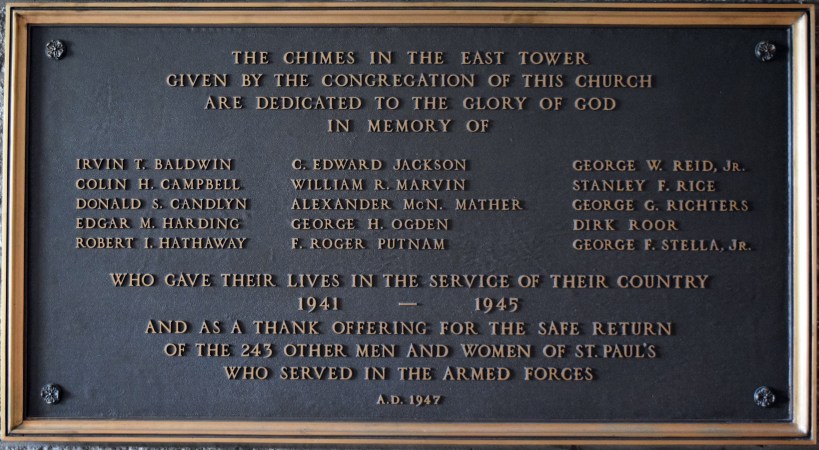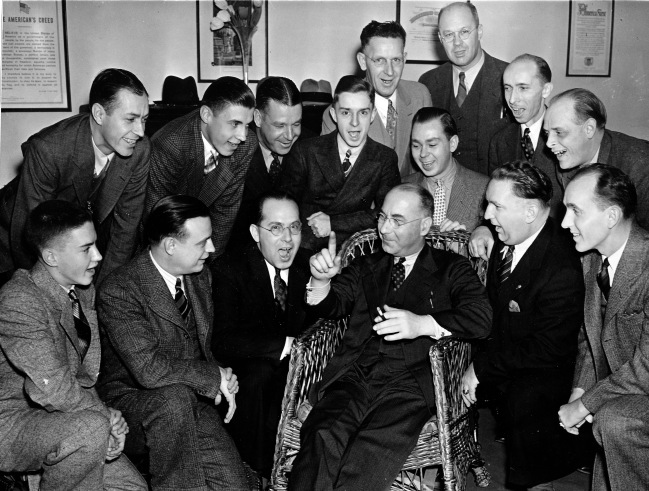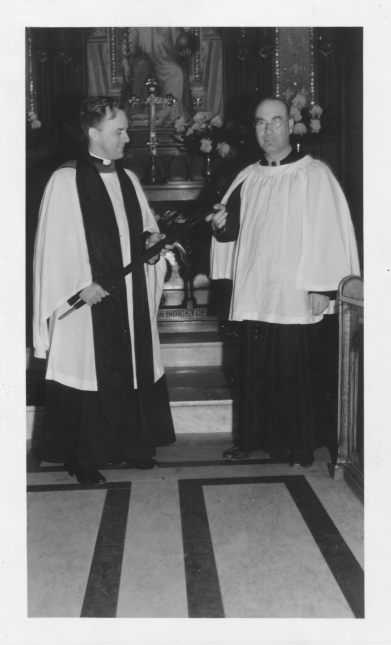A few weeks ago, St. Paul’s choir sang “Christ whose glory fills the skies,” one of the most popular works of T.Frederick H. Candlyn, our organist from 1915 until 1943.

T.F.H. Candlyn 25th Anniversary at St. Paul’s
As we finished singing the piece (one that we regularly perform with pleasure), I noticed the note on the last page: “Copyright 1942. Commissioned by the Eleventh Albany Diocesan Choir Festival, Albert F. Robinson, director,” and wondered (not for the first time) what the Festival was. Within the past ten years, the Cathedral of All Saints has hosted an Epiphany choir event, in which the choirs of Albany deanery parishes joined. Was the 1942 Festival similar to this more recent “Battle of the Choirs?” No one seemed to know, but the answer was to be found in newspapers of the time. And a very interesting story it was.

T. Frederick H. Candlyn at St. Paul’s organ.
The Albany Diocesan Choir Festival was begun in 1931 by J. William Jones, organist and choirmaster at All Saints Cathedral from 1929 until 1939. In the early years, these were small events, with just a few local choirs. But by the fourth annual Festival in 1935, with 22 choirs taking part, the festival had become a huge occasion, with (as a contemporary newspaper reported) “hundreds of voices” that was “attended each year by throngs.”
The 1935 festival was the culmination of a six-day “Festival Week of Music” at the Cathedral, including a concert of Candlyn’s compositions, sung by St. Paul’s choir and Candlyn’s chorus from the State College for Teachers. The week’s schedule was:
- Monday: recital by the Cathedral choir featuring works of Palestrina
- Tuesday: organ recital by Ernest White of Trinity Church, Lenox, Massachusetts
- Wednesday: recital by Major John A. Warner piano, Earle Hummel violin
- Thursday: concert of works of T. Frederick H. Candlyn
- Friday: a chorus of American Guild of Organist choirs, conducted by Dr. Russell Carter. The massed choir was composed of choirs from Reformed, Methodist, Presbyterian, Baptist congregations in Capital District.
- Saturday: Fourth Annual Diocesan Choir Festival, conducted by J. William Jones. Part of this service was broadcast on radio station WGY.
Candlyn was again involved in the 1936 event as accompanist. That year also he was also president of the Albany Diocesan Choirmasters’ Association, which was very active in promoting and organizing the festivals, but also in sponsoring recitals, conferences and in commissioning choral works. The Association even published a newsletter, “The Chorister.”

Cover of “The Chorister,” May 1941
Candlyn was also accompanist in 1937, when twenty massed choirs sang his work “Thee we adore,” which he dedicated to the Festival choir.

St. Paul’s Choir, with T.F.H. Candlyn, 1937
By 1938, the Festival had “grown to be of national importance,” and had become the model for other festivals across the United States. That year, the Albany Diocesan Choirmasters’ Association conducted district festivals in each of the diocese’s deaneries, preparing the parish choirs for the diocesan event in Albany. The Ogdensburg event, for example, gathered 200 choristers from 14 choirs to St. John’s, Ogdensburg for rehearsals and for a choral service presided over by Bishop G. AShton Oldham.

George Ashton Oldham, Bishop of Albany
1938 was also the first year that the Albany Diocesan Choirmasters’ Association commissioned new works to be performed at the festival. The composers and their works were:
- Healey Willan (1880 – 1968) of Church of St. Mary Magdalene, Toronto: “Before the ending of the day”
- Everett Titcomb (1884 – 1968) of Church of St. John the Evangelist, Boston, Massachusetts: “Benedictus es, Domine”
- Gardner C. Evans (1897 – 1951) of Church of Our Savior, Brookline, Massachusetts: “Thy kingdom come”
The Association arranged for publication of these works (as well as “Magnificat and Nun Dimittis” by Titcomb) by Carl Fischer, Inc., in Series I of The Albany Diocesan Choir Festival Series.

Healey Willan, “Before the Ending of the Day” cover obverse
In 1939, the Choir Festival was again part of “Festival of Music Week.” That year, the schedule was:
- Monday: Albany Federal Orchestra (an organization supported by the Works Project Administration)
- Tuesday: Liszt Choristers, Booker T. Washington Choral Society, Schenectady NYA Choir
- Wednesday: chamber music recital, again with pianist Major John A. Warner, as well as a violinist, a horn player and four cellists.
- Thursday: J. Stanley Lansing, Dean of the Eastern New York Chapter of the American Guild of Organists conducted a massed choir from nine area congregations
- Friday: organ recital by Thomas Mathews of St. Martin-in-the-Fields, Philadelphia
- Saturday: Albany Diocesan Festival, with 50 choirs, Mr. Jones conducting
William Jones, whose energy had moved the festival from small beginning into a project that “has spread throughout the length and breadth of the Diocese of Albany, with a fine organization of choirmasters and clergy as its sponsor and its own magazine which now has a national circulation” resigned from the Cathedral staff effective December 1, 1939, his tenth anniversary at the cathedral.

“Cathedral of All Saints” by Earle L. Kempton
Jones’ place as director of the Festival was taken by Albert F. Robinson, organist and choirmaster at Trinity Church, Potsdam. Albert F. Robinson oversaw the district festivals that year. We have a record of the Albany deanery festival, which drew 10 choirs to St. Andrew’s Church in Albany.
The 1941 Festival may have been the grandest of them all, with 50 choirs and 500 voices joined. Two new anthems were commissioned for the service:
- Alfred Whitehead (1887 – 1974) of Christ Church Cathedral, Montreal: “Come Thou Almighty King”
- Gardner C. Evans (1897 – 1951) of Church of Our Savior, Brookline, Massachusetts: “O Saving Victim”
These, along with the following piece (probably commissioned for the 1940 Festival) were published by the Diocesan Choirmasters’ Association in Series II of Fischer’s The Albany Diocesan Choir Festival Series:
- Charles O’Neill (1882-1964), professor at the State Teachers’ College at Potsdam, New York (now the Crane School of Music): “I will extol Thee”
As mentioned above, Candlyn’s work “Christ whose glory fills the skies” was commissioned for the 1942 festival. It also was published in Series II of the Fischer series. With the war on, this was a smaller event, held in conjunction with the Diocesan convention “to aid in conservation necessitated for war measures.” We assume that this refers to gasoline rationing, which would have made it very difficult to transport 50 choirs for a separate event. This year was to be Candlyn’s last at the Festival: in 1943 he resigned from St. Paul’s to become organist and choirmaster at St. Thomas Church in Manhatttan.

Healey Willan, “Before the Ending of the Day” cover reverse
The Diocesan Choir Festivals for 1943 and 1944 were again held in conjunction with the diocesan convention. There seems to have been a break during the last years of World War II.
The first Festival after the war was in 1947, when 500 singers from all parts of the diocese were directed by Duncan Trotter Gillespie, of St. George’s, Schenectady, and accompanied by organ and a brass choir from Albany High School. In 1950, in a sign that the festival had returned to its former glory, the regional festivals were held once again: the Albany deanery met at St. Andrew’s, and other events were held in Cohoes, Staatsville, Morris and Ogdensburg.
1951 was a slightly smaller event, with 25 choirs attending, but scheduling the festival with the newly-organized Tulip Festival helped with attendance: the audience, we are told, filled the cathedral to overflowing.

All Saints Cathedral (credit: Albany Group Archive)
Starting in the 1954, when the Choir Festival was again held in conjunction with the Tulip Festival, the director was W. Judson Rand Jr., organist and choirmaster of St. Peter’s church, who had been the festival’s organist back in 1941. The Diocesan Choirmasters’ Association continued to organize the event, which attracted 200 singer in 1955.
The last reference to the Festival that I’ve been able to find is an advertisement from 1965. It is a pity that we have lost this element of diocesan life. With smaller congregations and smaller choirs in many Episcopal churches, it would be difficult to organize such a festival today. But think of the benefits of bringing together musicians from across the diocese to meet, to form friendships, and to join together in song.













































 to obscurity a century ago.
to obscurity a century ago.